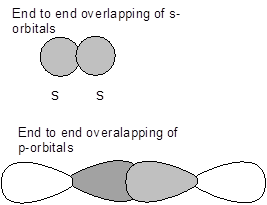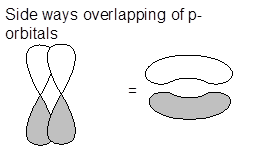
Explain how σ and
Interpretation:
The similarity and difference between s and p bonds is to be explained.
Concept Introduction:
- There are two types of bonds that are formed between the atoms-
- Electron in atoms occupy atomic orbitals while in molecule, electrons occupy molecular orbitals. These molecular orbitals are formed by the combination of the atomic orbitals and they can be bonding molecular orbitals and ant-bonding molecular orbitals.
- The process of mixing of atomic orbitals of similar energy to produce new molecular orbitals of equivalent energy is known as hybridization.
a) Covalent bond- the bond formed by the sharing of electrons between the atoms.
b) Ionic bond- When atoms gain/loss electrons and become ions, the electrostatic attraction between the oppositely charged ions is known as ionic bond.
Answer to Problem 1E
Similarity-They both are chemical covalent bonds and are formed by the overlapping of the atomic orbitals.
Differences-
| s- bond | ?-bond |
| Formed by the axial overlap of the atomic orbitals. | Formed by the side-ways overlap of the atomic orbitals. |
| It can be formed by the overlap of s-s, s-p or p-p orbitals. | It can only be formed by the overlap of p orbitals |
| Oriented along the internuclear axis. | Oriented perpendicular to the internuclear axis. |
| Exists independently. | Exist along with sigma bond. |
| Stronger than pi-bond. | Weaker than sigma bond. |
| More reactive. | Less reactive. |
| Determines the shape of the molecule. | Does not determine the shape of the molecule. |
Explanation of Solution
- Sigma (s) bonds- It is a type of covalent bond which is formed by the end to end overlapping of the atomic orbitals of the atoms involved in bonding.
- Pi (p)bonds -It is a type of covalent bond which is formed by the side wise overlapping of the atomic orbitals of the atoms involved in bonding.


Therefore, differences between sigma and pi bonds are-
| s- bond | ?-bond |
| Formed by the axial overlap of the atomic orbitals. | Formed by the side-ways overlap of the atomic orbitals. |
| It can be formed by the overlap of s-s, s-p or p-p orbitals. | It can only be formed by the overlap of p orbitals |
| Oriented along the internuclear axis. | Oriented perpendicular to the internuclear axis. |
| Exists independently. | Exist along with sigma bond. |
| Stronger than pi-bond. | Weaker than sigma bond. |
| More reactive. | Less reactive. |
| Determines the shape of the molecule. | Does not determine the shape of the molecule. |
However, the only similarity between these two are that they both are chemical covalent bonds and are formed by the overlapping the atomic orbitals, and the main difference is that sigma bond is formed by the axial overlap of the atomic orbitals, whereas, pi bond is formed by the sideways overlapping of atomic orbitals.
Want to see more full solutions like this?
Chapter 5 Solutions
Chemistry: Atoms First
- १ eq ine teaching and × + rn/takeAssignment/takeCovalentActivity.do?locator-assignment-take [Review Topics] [References] Write an acceptable IUPAC name for the compound below. (Only systematic names, not common names are accepted by this question.) Keep the information page open for feedback reference. The IUPAC name is In progress mit Answer Retry Entire Group 5 more group attempts remaining Cengage Learning | Cengage Technical Support Save and Exitarrow_forwardDraw the molecules.arrow_forwardDraw the mechanism for the acid-catalyzed dehydration of 2-methyl-hexan-2-ol with arrows please.arrow_forward
- . Draw the products for addition reactions (label as major or minor) of the reaction between 2-methyl-2-butene and with following reactants : Steps to follow : A. These are addition reactions you need to break a double bond and make two products if possible. B. As of Markovnikov rule the hydrogen should go to that double bond carbon which has more hydrogen to make stable products or major product. Here is the link for additional help : https://study.com/academy/answer/predict-the-major-and-minor-products-of-2-methyl- 2-butene-with-hbr-as-an-electrophilic-addition-reaction-include-the-intermediate- reactions.html H₂C CH3 H H3C CH3 2-methyl-2-butene CH3 Same structure CH3 IENCESarrow_forwardDraw everything on a piece of paper including every single step and each name provided using carbons less than 3 please.arrow_forwardTopics] [References] Write an acceptable IUPAC name for the compound below. (Only systematic names, not common names are accepted by this question.) Keep the information page open for feedback reference. H The IUPAC name isarrow_forward
- [Review Topics] [References] Write an acceptable IUPAC name for the compound below. (Only systematic names, not common names are accepted by this question.) Keep the information page open for feedback reference. The IUPAC name is Submit Answer Retry Entire Group 9 more group attempts remainingarrow_forwardPlease draw.arrow_forwardA chromatogram with ideal Gaussian bands has tR = 9.0 minutes and w1/2 = 2.0 minutes. Find the number of theoretical plates that are present, and calculate the height of each theoretical plate if the column is 10 centimeters long.arrow_forward
- An open tubular column has an inner diameter of 207 micrometers, and the thickness of the stationary phase on the inner wall is 0.50 micrometers. Unretained solute passes through in 63 seconds and a particular solute emerges at 433 seconds. Find the distribution constant for this solute and find the fraction of time spent in the stationary phase.arrow_forwardConsider a chromatography column in which Vs= Vm/5. Find the retention factor if Kd= 3 and Kd= 30.arrow_forwardTo improve chromatographic separation, you must: Increase the number of theoretical plates on the column. Increase the height of theoretical plates on the column. Increase both the number and height of theoretical plates on the column. Increasing the flow rate of the mobile phase would Increase longitudinal diffusion Increase broadening due to mass transfer Increase broadening due to multiple paths You can improve the separation of components in gas chromatography by: Rasing the temperature of the injection port Rasing the temperature of the column isothermally Rasing the temperature of the column using temperature programming In GC, separation between two different solutes occurs because the solutes have different solubilities in the mobile phase the solutes volatilize at different rates in the injector the solutes spend different amounts of time in the stationary phasearrow_forward
 Chemistry: The Molecular ScienceChemistryISBN:9781285199047Author:John W. Moore, Conrad L. StanitskiPublisher:Cengage Learning
Chemistry: The Molecular ScienceChemistryISBN:9781285199047Author:John W. Moore, Conrad L. StanitskiPublisher:Cengage Learning Chemistry: Principles and PracticeChemistryISBN:9780534420123Author:Daniel L. Reger, Scott R. Goode, David W. Ball, Edward MercerPublisher:Cengage Learning
Chemistry: Principles and PracticeChemistryISBN:9780534420123Author:Daniel L. Reger, Scott R. Goode, David W. Ball, Edward MercerPublisher:Cengage Learning General Chemistry - Standalone book (MindTap Cour...ChemistryISBN:9781305580343Author:Steven D. Gammon, Ebbing, Darrell Ebbing, Steven D., Darrell; Gammon, Darrell Ebbing; Steven D. Gammon, Darrell D.; Gammon, Ebbing; Steven D. Gammon; DarrellPublisher:Cengage Learning
General Chemistry - Standalone book (MindTap Cour...ChemistryISBN:9781305580343Author:Steven D. Gammon, Ebbing, Darrell Ebbing, Steven D., Darrell; Gammon, Darrell Ebbing; Steven D. Gammon, Darrell D.; Gammon, Ebbing; Steven D. Gammon; DarrellPublisher:Cengage Learning Chemistry & Chemical ReactivityChemistryISBN:9781133949640Author:John C. Kotz, Paul M. Treichel, John Townsend, David TreichelPublisher:Cengage Learning
Chemistry & Chemical ReactivityChemistryISBN:9781133949640Author:John C. Kotz, Paul M. Treichel, John Townsend, David TreichelPublisher:Cengage Learning Chemistry & Chemical ReactivityChemistryISBN:9781337399074Author:John C. Kotz, Paul M. Treichel, John Townsend, David TreichelPublisher:Cengage Learning
Chemistry & Chemical ReactivityChemistryISBN:9781337399074Author:John C. Kotz, Paul M. Treichel, John Townsend, David TreichelPublisher:Cengage Learning Chemistry for Engineering StudentsChemistryISBN:9781337398909Author:Lawrence S. Brown, Tom HolmePublisher:Cengage Learning
Chemistry for Engineering StudentsChemistryISBN:9781337398909Author:Lawrence S. Brown, Tom HolmePublisher:Cengage Learning





